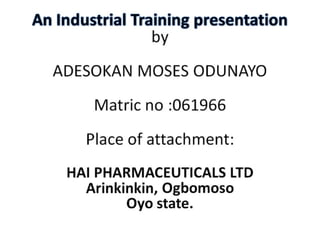Ayo Adesokan final
- 1. Ėý
- 2. ORGANOGRAM CHAIRMAN (CEO) SUPERINTENDENT PHARMACIST QUALITY ASSURANCE DEPT PRODUCTION DEPT PACKAGING DEPT ACCOUNTING DEPT IN PROCESS SECTION CHEMICAL LABORATORY MICROBIOLOGICAL LABORATORY SYRUP MIXING ROOM COMPOUNDING ROOM TABLET SECTION BLISTERING ROOM CHIEF ACCOUNTANT
- 3. PRODUCTS OF HAI PHARMACEUTICALS HAIDOMOL TABLETS HAIDOMOL SYRUP VITAMIN B COMPLEX TABLETS HAICOF (COUGH SYRUP) HAITREX BABY TEETHING MIXTURE HAIDOMOL CAPLETS
- 4. PRODUCTION CHART FOR TABLETS INGREDIENTS Paracetamol powder (active ingredient) Starch corn Talc Magnessium stearate Methyl paraben Ethyl paraben WEIGHING OF INGREDIENTS DRY MILLING GRANULATION MIXING OF INGREDIENTS COMPRESSION BLISTERING DRYING FINAL DRYING Preservatives
- 5. PRESERVATIVES OF PHARMACEUTICAL RELEVANCE What are preservatives ? Preservatives are substances commonly added to food and pharmaceutical products to prolong their shelf life. The addition of preservatives to such product , especially those that have higher water content is essential to avoid alteration and degradation by microorganism during storage. PRESERVATIVES: Must be harmless. Must not impair the bioavailability of the drug or its therapeutic efficacy. Must not interfere with pharmacopeias compliance analysis of the drug.
- 6. THE PARABENS Parabens are esters of (4-hydroxybenzoic acid) that are widely used as preservatives in drugs and foodstuffs. Their antimicrobial activity increases with chain length.
- 7. METABOLISM OF PARABENS Parabens are extensively metabolized in the human body . They are hydrolysed to 4-hydroxy bezoic acid by esterases in the liver and then conjugated with sulphate, glucoronide or glycine. They are excreted in the urine in their conjugated forms.
- 8. PARABEN HYDROLYSIS AND CONJUGATION REACTIONS
- 9. CLINICAL SIGNIFICANCE The active biotransformation of parabens in man is likely to prevent its accumulation and thus prevent any possible toxicity. OTHER USES OF PARABENS Parabens are also used as a preservative in the following products: Hair care products, creams, moisturizers, shaving creams, shampoos, lip sticks, etc
- 10. CONCLUSION When administering drug, we should all understand we are not only ingesting the active ingredient but alongside various other additives (preservatives, colourants etc). We should therefore seek to know the total constituent of whatever drug we administer. Thank you









